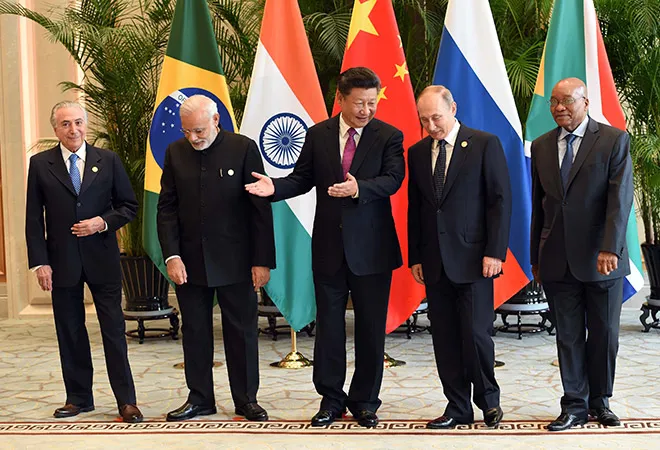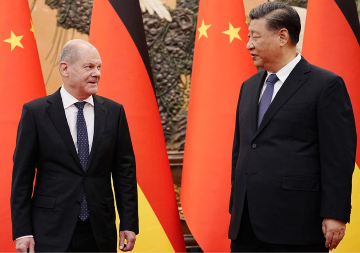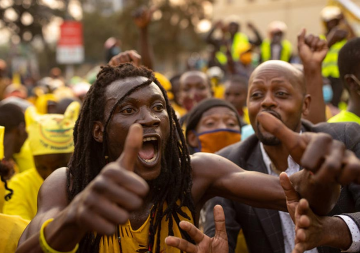Russia has revamped its South Asia policy in recent months with a major outreach to Pakistan and stepping forward as a power broker in Afghanistan, its former stomping ground. With the help of its newfound strategic partner China, Russia intends to checkmate the United States’ regional pre-eminence. But the maneuvering has also brought Moscow in opposition to New Delhi with which it has traditionally shared robust ties. Any new power equation in the region will have long-term implications.
Since the 1960s Russia has been a close partner of India in South Asia. This relationship has stood the test of time even as global power equation changed after the end of the Cold War. During the Cold War, the high point of the relationship was the signing of the 1971 Indo–Soviet Treaty of Peace, Friendship and Cooperation, which signaled a decisive shift away from the West in response to an emerging US-Pakistan-China axis in South Asia. Though not an explicit military alliance, this treaty was sharp departure from India’s professed policy of non-alignment, and New Delhi emerged a close partner of the Soviet Union during the Cold War. The treaty in effect created deterrence against any form of US-Pakistan-China detente and rendered India increasingly dependent on the Soviet Union for defense capabilities.
The relationship’s economic dimension was never strong, and the fall of the Berlin Wall exposed the foundations of Indo-Russian ties to new vulnerabilities. Russia’s position as India’s defense supplier of choice has increasingly come under pressure since the 1990s when the West opened to India. Still, Russia and India continued to recognize the need for each other. India, the world’s top defense importer, is overseeing an upgrade of its mostly Soviet-era military equipment. Russia is the world’s second largest arms exporter, trailing the United States. In 2016, India and Russia signed major defense deals worth billions of dollars, including pacts for five S-400 Triumf air defense systems, four stealth frigates and a joint venture to manufacture Kamov-226T light utility helicopters in India.
India is a challenging market for US defense exporters, and Russia has traditionally been willing to go along with “make in India” policies promoting indigenous production. For its defense matrix, India cannot afford to marginalize Russia as it still is the only country selling critical strategic technologies to India.
In recent years India has grown concerned about Russia’s growing closeness to China and especially the overtures to Pakistan. Vladimir Putin, intent on viewing South Asia through the prism of Russia’s geopolitical competition with the West, may have decided that the time was right for tilting towards Pakistan. US-Pakistan ties may have hit their nadir and the new US administration, expressing isolationist tendencies, remains consumed by multiple domestic crises.
The global arms market has become more difficult for Russia to navigate, with China deciding to produce its own weapons rather than procuring them from Russia. Moscow needs new buyers.
Moscow and Islamabad held their first joint military exercise in September 2016 and their first bilateral consultation on regional issues in December. Russia lifted an arms embargo against Pakistan in 2014 and will send four Mi-35M attack helicopters this year. Russian troops participated in this year’s Pakistan Day military parade. And the China-Pakistan Economic Corridor linking Xinjiang to the Pakistani port of Gwadar could be merged with the Russia-backed Eurasian Economic Union.
But causing real consternation in New Delhi is Moscow’s decision to side with China in ensuring that Pakistan does not get isolated globally. At the 2016 BRICS summit in Goa, Russia did not back India’s demand to name two Pakistan-based terror groups as perpetrators of terrorism against India, thereby shielding Pakistan from censure.
This shift in Russian stance is also evident in the role that it envisions for itself in Afghanistan, coming almost four decades after the 1979 Soviet invasion of the country. Russia hosted a February six-nation conference in Moscow on Afghanistan’s future with participation from India, Iran, Pakistan, China and Afghanistan. This was Russia’s second initiative after the first trilateral conference in December, including only China and Pakistan.
The December conference agreed upon “a flexible approach to remove certain figures from sanctions lists as part of efforts to foster a peaceful dialogue between Kabul and the Taliban movement.” The three states underscored their concern “about the rising activity in the country of extremist groups, including the Afghan branch of IS ” and underlined that the Taliban is a necessary bulwark in the global fight against the Islamic State. Kabul and other partners like New Delhi were surprised, while the Taliban was ecstatic. "It is joyous to see that the regional countries have also understood that the Islamic Emirate of Afghanistan is a political and military force,” noted a statement issued on the Taliban’s behalf. “The proposal forwarded in the Moscow tripartite of delisting members of the Islamic Emirate is a positive step forward in bringing peace and security to Afghanistan.”
Read also | < style="color: #960f0f">The return of the great game in Afghanistan
Russia faced flak for not inviting Afghanistan to the December conference. The US-backed Afghan government had registered a strong protest after its exclusion, underlining that, regardless of participants’ intentions, excluding Kabul would not help stabilize the country.
So Moscow was more careful for the February meeting, broadening outreach by inviting India, Iran, Afghanistan and most regional stakeholders while pointedly excluding the United States and NATO. It was left to Afghanistan to underscore US centrality in the country’s unfolding dynamic and to push for inclusion of the United States as one of its most important partners to “end war and usher in sustainable peace in Afghanistan.”
Afghanistan also took on Pakistan at the conference when it underlined the need to “effect a change in the behavior of certain state actors” to end the violence that has reached record levels in the last year. Afghanistan also strongly pushed back against the “good Taliban, bad Taliban” discourse being championed by Russia, China and Pakistan. The Afghan representative at the talks, M. Ashraf Haidari, argued: “the key challenge to the process remains a policy selectivity by some to distinguish between good and bad terrorists, even though terrorism is a common threat that confronts the whole region, where if one of us doesn’t stand firm against it, others’ counterterrorism efforts will not bear the results we all seek.”
Of course, New Delhi welcomed that stance, arguing that Afghan-led and Afghan-owned reconciliation efforts should be facilitated by “friends and well-wishers of Afghanistan.” Targeting Pakistan, India also reiterated that denying “safe havens or sanctuaries to any terrorist group or individual in countries of our region,” remains central for the long-term stability of Afghanistan.
Russia is now planning to host another round of talks on the conflict in Afghanistan on April 14, and 12 countries, including the United States and five Central Asian nations, have been invited to attend. Ahead of this meeting, Pakistan recently brought together seven top Taliban leaders in Islamabad to cajole them for the peace talks.
Moscow has established itself as the leading power broker in the conflict-ridden country, since most NATO forces withdrew in 2014 and where 8,400 American soldiers remain. NATO's supreme allied commander in Europe, General Curtis Scaparrotti, recently warned that he had “seen the influence of Russia of late - increased influence in terms of association and perhaps even supply to the Taliban."
Russia, in concert with China, challenges US strategic priorities on multiple fronts, and regional theaters like South Asia are likely to face the brunt of this geopolitical competition, putting older relationships under strain even as new ones take shape. The new Great Game for South Asia has only just begun.
This commentary originally appeared in YaleGlobal Online.
The views expressed above belong to the author(s). ORF research and analyses now available on Telegram! Click here to access our curated content — blogs, longforms and interviews.




 PREV
PREV


